Comprehensive Report: Meal Management & Product Development at Zizzi
VerifiedAdded on 2020/06/04
|8
|1921
|101
Report
AI Summary
This report provides a comprehensive analysis of meal management and product development strategies at Zizzi Restaurant, an Italian-themed restaurant chain. It explores the principles and factors involved in recipe development, emphasizing customer expectations, food product methods, and social responses. The report delves into menu planning decisions, considering menu compilation, variety, and time management. It examines various service methods like buffet, English service, and cafeteria services, evaluating their advantages and disadvantages. The report outlines the stages of menu product development planning, including sales mix, competitor activity, and feasibility studies. It also discusses the influences of social, economic, domestic, and media factors on the development process, highlighting the importance of staff skills. The conclusion summarizes the strategic processes for introducing new and quality products, emphasizing the importance of analyzing principles and factors in recipe development and product planning. This report is a valuable resource for students studying business development and restaurant management.

MEAL MANAGEMENT
&
PRODUCT DEVELOPMENT
&
PRODUCT DEVELOPMENT
Paraphrase This Document
Need a fresh take? Get an instant paraphrase of this document with our AI Paraphraser
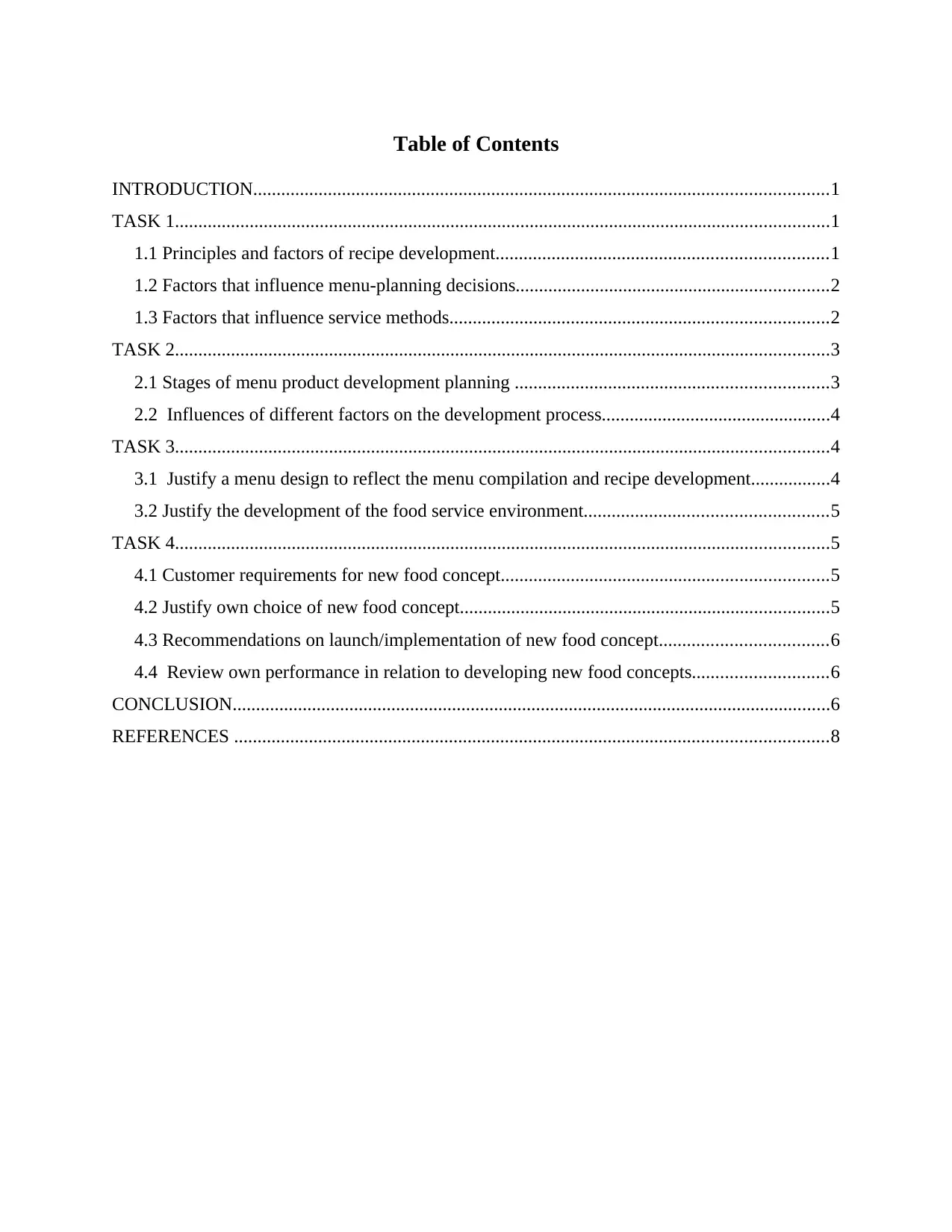
Table of Contents
INTRODUCTION...........................................................................................................................1
TASK 1............................................................................................................................................1
1.1 Principles and factors of recipe development.......................................................................1
1.2 Factors that influence menu-planning decisions...................................................................2
1.3 Factors that influence service methods.................................................................................2
TASK 2............................................................................................................................................3
2.1 Stages of menu product development planning ...................................................................3
2.2 Influences of different factors on the development process.................................................4
TASK 3............................................................................................................................................4
3.1 Justify a menu design to reflect the menu compilation and recipe development.................4
3.2 Justify the development of the food service environment....................................................5
TASK 4............................................................................................................................................5
4.1 Customer requirements for new food concept......................................................................5
4.2 Justify own choice of new food concept...............................................................................5
4.3 Recommendations on launch/implementation of new food concept....................................6
4.4 Review own performance in relation to developing new food concepts.............................6
CONCLUSION................................................................................................................................6
REFERENCES ...............................................................................................................................8
INTRODUCTION...........................................................................................................................1
TASK 1............................................................................................................................................1
1.1 Principles and factors of recipe development.......................................................................1
1.2 Factors that influence menu-planning decisions...................................................................2
1.3 Factors that influence service methods.................................................................................2
TASK 2............................................................................................................................................3
2.1 Stages of menu product development planning ...................................................................3
2.2 Influences of different factors on the development process.................................................4
TASK 3............................................................................................................................................4
3.1 Justify a menu design to reflect the menu compilation and recipe development.................4
3.2 Justify the development of the food service environment....................................................5
TASK 4............................................................................................................................................5
4.1 Customer requirements for new food concept......................................................................5
4.2 Justify own choice of new food concept...............................................................................5
4.3 Recommendations on launch/implementation of new food concept....................................6
4.4 Review own performance in relation to developing new food concepts.............................6
CONCLUSION................................................................................................................................6
REFERENCES ...............................................................................................................................8
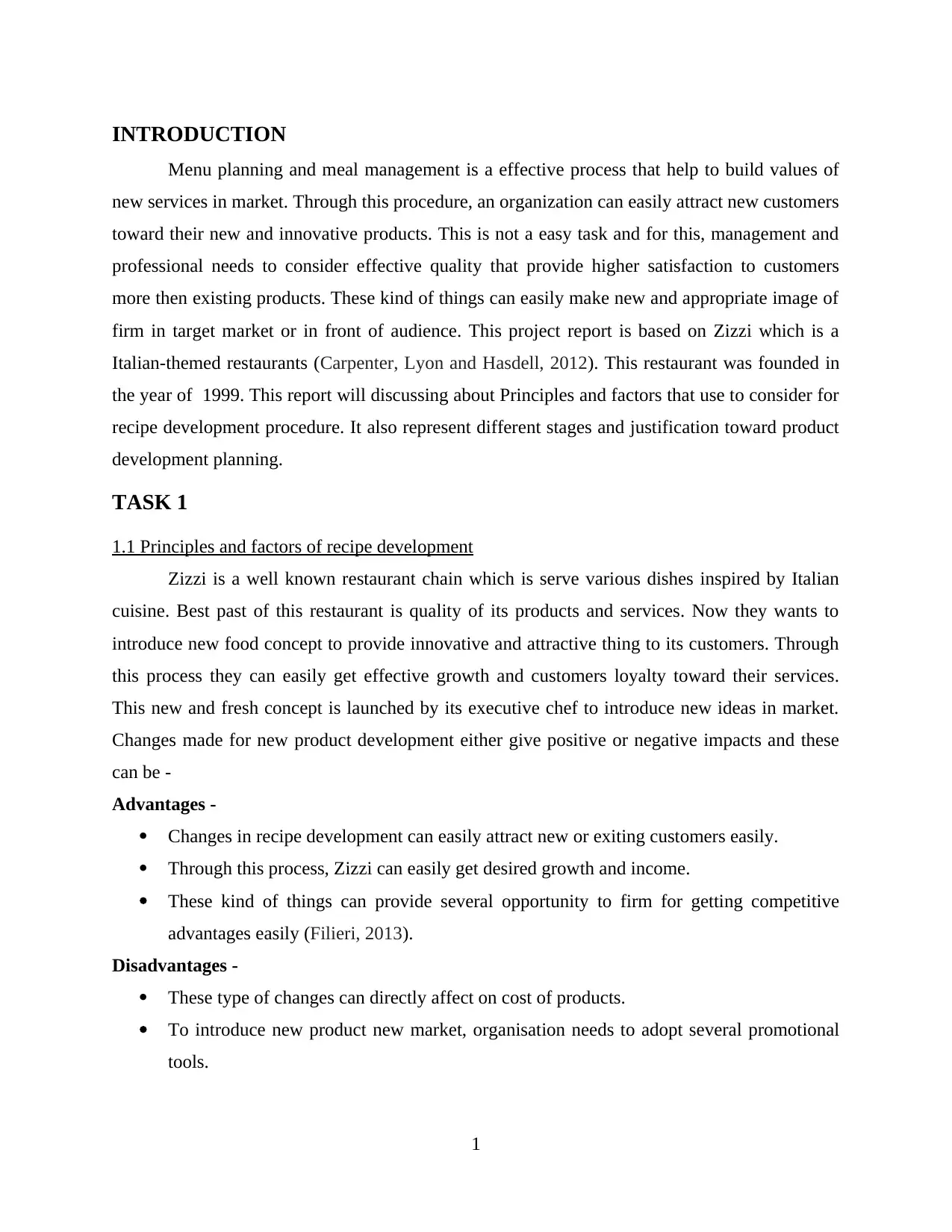
INTRODUCTION
Menu planning and meal management is a effective process that help to build values of
new services in market. Through this procedure, an organization can easily attract new customers
toward their new and innovative products. This is not a easy task and for this, management and
professional needs to consider effective quality that provide higher satisfaction to customers
more then existing products. These kind of things can easily make new and appropriate image of
firm in target market or in front of audience. This project report is based on Zizzi which is a
Italian-themed restaurants (Carpenter, Lyon and Hasdell, 2012). This restaurant was founded in
the year of 1999. This report will discussing about Principles and factors that use to consider for
recipe development procedure. It also represent different stages and justification toward product
development planning.
TASK 1
1.1 Principles and factors of recipe development
Zizzi is a well known restaurant chain which is serve various dishes inspired by Italian
cuisine. Best past of this restaurant is quality of its products and services. Now they wants to
introduce new food concept to provide innovative and attractive thing to its customers. Through
this process they can easily get effective growth and customers loyalty toward their services.
This new and fresh concept is launched by its executive chef to introduce new ideas in market.
Changes made for new product development either give positive or negative impacts and these
can be -
Advantages -
Changes in recipe development can easily attract new or exiting customers easily.
Through this process, Zizzi can easily get desired growth and income.
These kind of things can provide several opportunity to firm for getting competitive
advantages easily (Filieri, 2013).
Disadvantages -
These type of changes can directly affect on cost of products.
To introduce new product new market, organisation needs to adopt several promotional
tools.
1
Menu planning and meal management is a effective process that help to build values of
new services in market. Through this procedure, an organization can easily attract new customers
toward their new and innovative products. This is not a easy task and for this, management and
professional needs to consider effective quality that provide higher satisfaction to customers
more then existing products. These kind of things can easily make new and appropriate image of
firm in target market or in front of audience. This project report is based on Zizzi which is a
Italian-themed restaurants (Carpenter, Lyon and Hasdell, 2012). This restaurant was founded in
the year of 1999. This report will discussing about Principles and factors that use to consider for
recipe development procedure. It also represent different stages and justification toward product
development planning.
TASK 1
1.1 Principles and factors of recipe development
Zizzi is a well known restaurant chain which is serve various dishes inspired by Italian
cuisine. Best past of this restaurant is quality of its products and services. Now they wants to
introduce new food concept to provide innovative and attractive thing to its customers. Through
this process they can easily get effective growth and customers loyalty toward their services.
This new and fresh concept is launched by its executive chef to introduce new ideas in market.
Changes made for new product development either give positive or negative impacts and these
can be -
Advantages -
Changes in recipe development can easily attract new or exiting customers easily.
Through this process, Zizzi can easily get desired growth and income.
These kind of things can provide several opportunity to firm for getting competitive
advantages easily (Filieri, 2013).
Disadvantages -
These type of changes can directly affect on cost of products.
To introduce new product new market, organisation needs to adopt several promotional
tools.
1
⊘ This is a preview!⊘
Do you want full access?
Subscribe today to unlock all pages.

Trusted by 1+ million students worldwide

Principles of recipe development- There are various principle of recipe development are
representing that Zizzi needs to follow for their new strategy as-
Consumers expectation – Customer are most important factor in an organisation who
takes different services in those places. So for them, Zizzi needs to produce new product
according to their exception and demand.
Food product methods – This is a most important issue that can directly effect on recipe
development procedure. So for this, organisation needs to use new and unique method fro
introducing new product in market (Fuller, 2016).
Social response – After introducing new product in market, Zizzi needs to analyse social
and customer's response toward their services.
1.2 Factors that influence menu-planning decisions
Menu planning is not an easy task because for this overall management needs to consider
each and every factor that can affect their customer and product's values. There are some factors
are given below that influence menu-planning decisions -
Menu compilation – This is a one most important factor that directly affect on menu
planning decision. For this executive chef and management needs to consider material and
component that they use for new product.
Variety – In hospitality industry, it is require that they serve variety of products to their
customers. Through this they can easily attract them toward their meal. These type of things
provide various ideas to customers for choose best tuition according to their taste.
Time management – This is a most important factor that executive chef needs to
consider in their food making process. If a dish take too much time to get ready then in between
this duration management needs to divert customers mind on others things otherwise they can be
frustrated in between waiting duration (Harrington and Ottenbacher, 2013).
1.3 Factors that influence service methods
In hospitality industry takes a most important place that attract customers toward their
serving methods. These factors re related to customers needs and demand that organisation needs
to fulfil in exact manner. There are various service methods are given below such as -
Buffet services – This is a common service method in which restaurant arrange various food
varieties on a side table. In it, customers needs to serve their food by own according to their
2
representing that Zizzi needs to follow for their new strategy as-
Consumers expectation – Customer are most important factor in an organisation who
takes different services in those places. So for them, Zizzi needs to produce new product
according to their exception and demand.
Food product methods – This is a most important issue that can directly effect on recipe
development procedure. So for this, organisation needs to use new and unique method fro
introducing new product in market (Fuller, 2016).
Social response – After introducing new product in market, Zizzi needs to analyse social
and customer's response toward their services.
1.2 Factors that influence menu-planning decisions
Menu planning is not an easy task because for this overall management needs to consider
each and every factor that can affect their customer and product's values. There are some factors
are given below that influence menu-planning decisions -
Menu compilation – This is a one most important factor that directly affect on menu
planning decision. For this executive chef and management needs to consider material and
component that they use for new product.
Variety – In hospitality industry, it is require that they serve variety of products to their
customers. Through this they can easily attract them toward their meal. These type of things
provide various ideas to customers for choose best tuition according to their taste.
Time management – This is a most important factor that executive chef needs to
consider in their food making process. If a dish take too much time to get ready then in between
this duration management needs to divert customers mind on others things otherwise they can be
frustrated in between waiting duration (Harrington and Ottenbacher, 2013).
1.3 Factors that influence service methods
In hospitality industry takes a most important place that attract customers toward their
serving methods. These factors re related to customers needs and demand that organisation needs
to fulfil in exact manner. There are various service methods are given below such as -
Buffet services – This is a common service method in which restaurant arrange various food
varieties on a side table. In it, customers needs to serve their food by own according to their
2
Paraphrase This Document
Need a fresh take? Get an instant paraphrase of this document with our AI Paraphraser
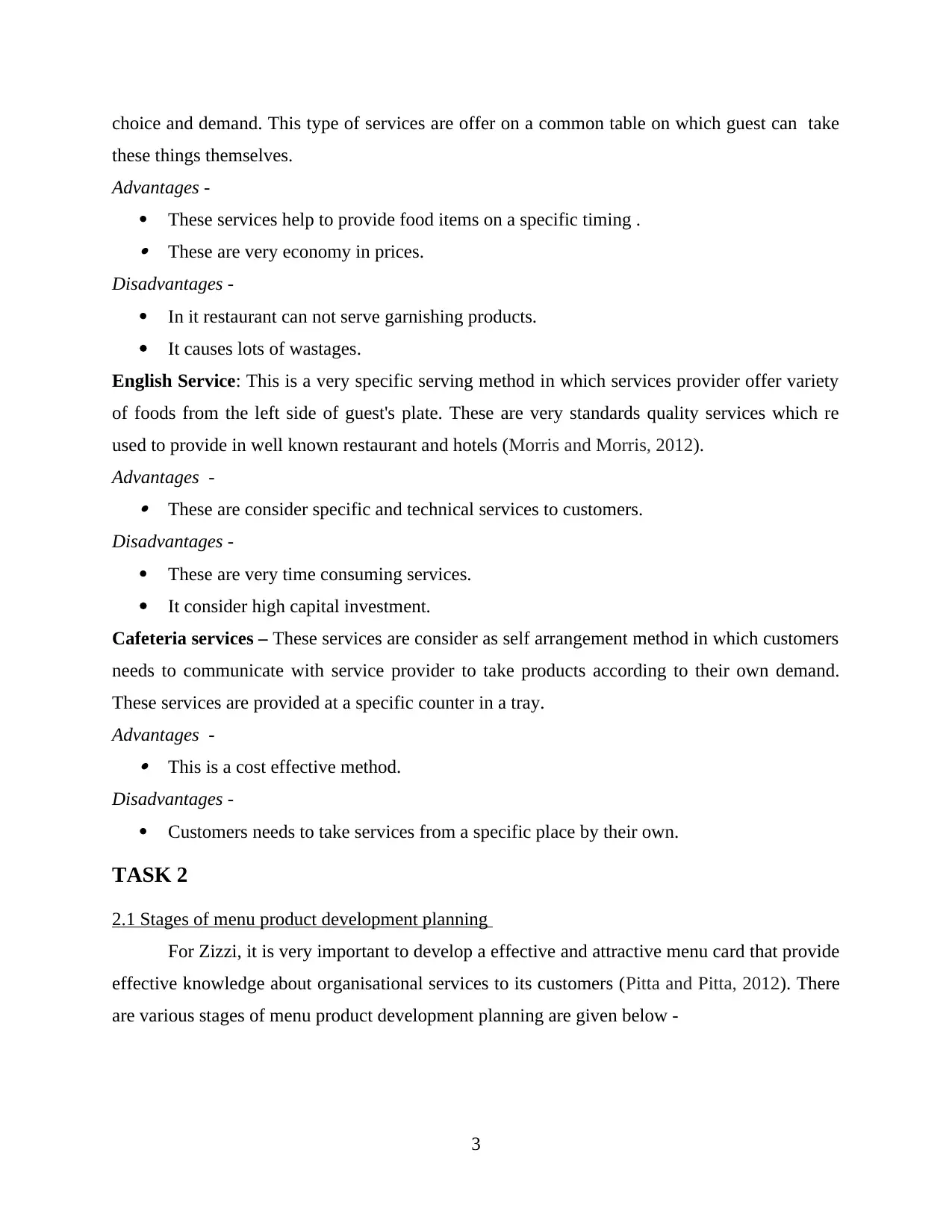
choice and demand. This type of services are offer on a common table on which guest can take
these things themselves.
Advantages -
These services help to provide food items on a specific timing . These are very economy in prices.
Disadvantages -
In it restaurant can not serve garnishing products.
It causes lots of wastages.
English Service: This is a very specific serving method in which services provider offer variety
of foods from the left side of guest's plate. These are very standards quality services which re
used to provide in well known restaurant and hotels (Morris and Morris, 2012).
Advantages - These are consider specific and technical services to customers.
Disadvantages -
These are very time consuming services.
It consider high capital investment.
Cafeteria services – These services are consider as self arrangement method in which customers
needs to communicate with service provider to take products according to their own demand.
These services are provided at a specific counter in a tray.
Advantages - This is a cost effective method.
Disadvantages -
Customers needs to take services from a specific place by their own.
TASK 2
2.1 Stages of menu product development planning
For Zizzi, it is very important to develop a effective and attractive menu card that provide
effective knowledge about organisational services to its customers (Pitta and Pitta, 2012). There
are various stages of menu product development planning are given below -
3
these things themselves.
Advantages -
These services help to provide food items on a specific timing . These are very economy in prices.
Disadvantages -
In it restaurant can not serve garnishing products.
It causes lots of wastages.
English Service: This is a very specific serving method in which services provider offer variety
of foods from the left side of guest's plate. These are very standards quality services which re
used to provide in well known restaurant and hotels (Morris and Morris, 2012).
Advantages - These are consider specific and technical services to customers.
Disadvantages -
These are very time consuming services.
It consider high capital investment.
Cafeteria services – These services are consider as self arrangement method in which customers
needs to communicate with service provider to take products according to their own demand.
These services are provided at a specific counter in a tray.
Advantages - This is a cost effective method.
Disadvantages -
Customers needs to take services from a specific place by their own.
TASK 2
2.1 Stages of menu product development planning
For Zizzi, it is very important to develop a effective and attractive menu card that provide
effective knowledge about organisational services to its customers (Pitta and Pitta, 2012). There
are various stages of menu product development planning are given below -
3
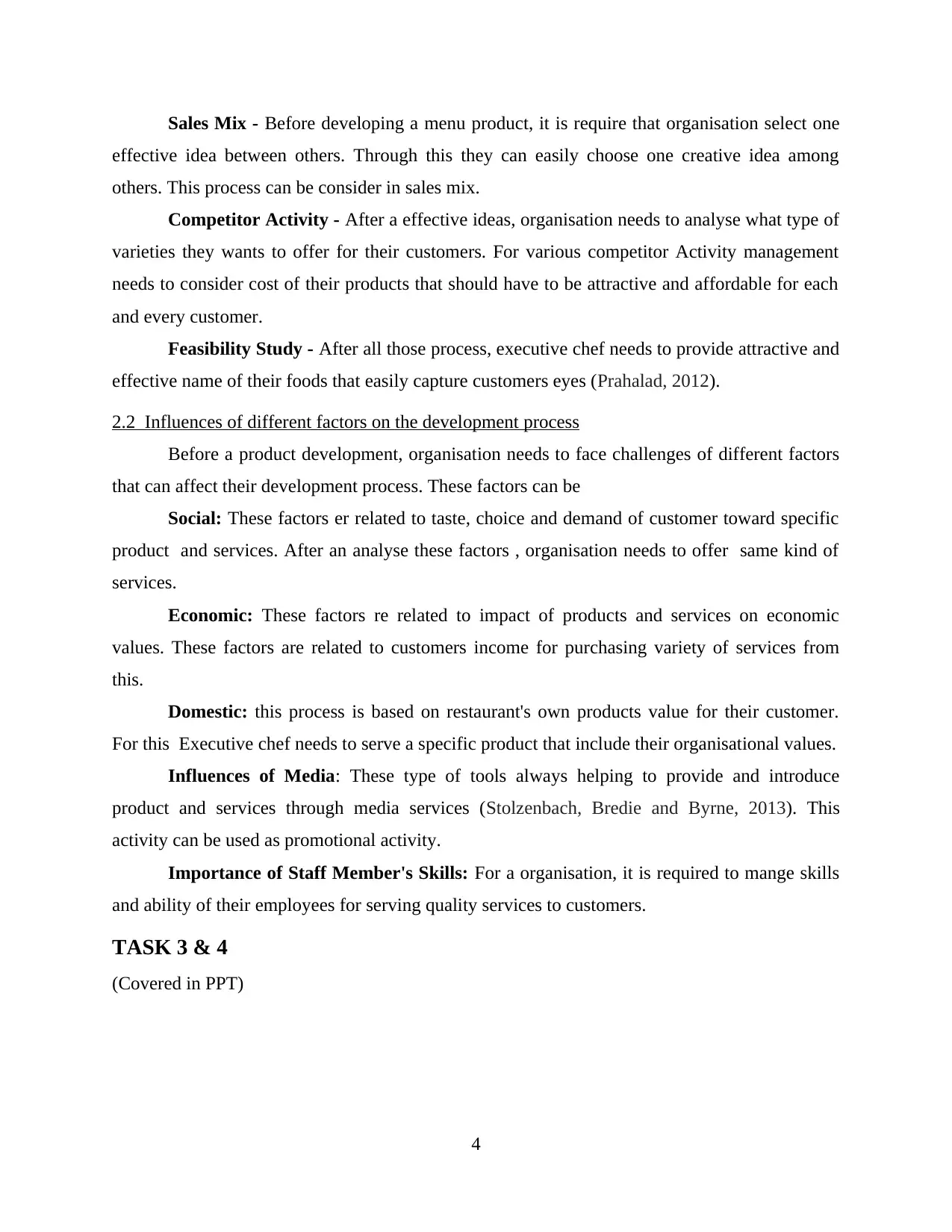
Sales Mix - Before developing a menu product, it is require that organisation select one
effective idea between others. Through this they can easily choose one creative idea among
others. This process can be consider in sales mix.
Competitor Activity - After a effective ideas, organisation needs to analyse what type of
varieties they wants to offer for their customers. For various competitor Activity management
needs to consider cost of their products that should have to be attractive and affordable for each
and every customer.
Feasibility Study - After all those process, executive chef needs to provide attractive and
effective name of their foods that easily capture customers eyes (Prahalad, 2012).
2.2 Influences of different factors on the development process
Before a product development, organisation needs to face challenges of different factors
that can affect their development process. These factors can be
Social: These factors er related to taste, choice and demand of customer toward specific
product and services. After an analyse these factors , organisation needs to offer same kind of
services.
Economic: These factors re related to impact of products and services on economic
values. These factors are related to customers income for purchasing variety of services from
this.
Domestic: this process is based on restaurant's own products value for their customer.
For this Executive chef needs to serve a specific product that include their organisational values.
Influences of Media: These type of tools always helping to provide and introduce
product and services through media services (Stolzenbach, Bredie and Byrne, 2013). This
activity can be used as promotional activity.
Importance of Staff Member's Skills: For a organisation, it is required to mange skills
and ability of their employees for serving quality services to customers.
TASK 3 & 4
(Covered in PPT)
4
effective idea between others. Through this they can easily choose one creative idea among
others. This process can be consider in sales mix.
Competitor Activity - After a effective ideas, organisation needs to analyse what type of
varieties they wants to offer for their customers. For various competitor Activity management
needs to consider cost of their products that should have to be attractive and affordable for each
and every customer.
Feasibility Study - After all those process, executive chef needs to provide attractive and
effective name of their foods that easily capture customers eyes (Prahalad, 2012).
2.2 Influences of different factors on the development process
Before a product development, organisation needs to face challenges of different factors
that can affect their development process. These factors can be
Social: These factors er related to taste, choice and demand of customer toward specific
product and services. After an analyse these factors , organisation needs to offer same kind of
services.
Economic: These factors re related to impact of products and services on economic
values. These factors are related to customers income for purchasing variety of services from
this.
Domestic: this process is based on restaurant's own products value for their customer.
For this Executive chef needs to serve a specific product that include their organisational values.
Influences of Media: These type of tools always helping to provide and introduce
product and services through media services (Stolzenbach, Bredie and Byrne, 2013). This
activity can be used as promotional activity.
Importance of Staff Member's Skills: For a organisation, it is required to mange skills
and ability of their employees for serving quality services to customers.
TASK 3 & 4
(Covered in PPT)
4
⊘ This is a preview!⊘
Do you want full access?
Subscribe today to unlock all pages.

Trusted by 1+ million students worldwide

CONCLUSION
As per the above report it has been summarised that if a organisation want to introduce
new and quality produce to their customer then they needs to implement strategical process in
their services. For this they needs to use effective procedure as analysis of principles and factors
that use to consider for recipe development as well as represent different stages and justification
toward product development planning.
5
As per the above report it has been summarised that if a organisation want to introduce
new and quality produce to their customer then they needs to implement strategical process in
their services. For this they needs to use effective procedure as analysis of principles and factors
that use to consider for recipe development as well as represent different stages and justification
toward product development planning.
5
Paraphrase This Document
Need a fresh take? Get an instant paraphrase of this document with our AI Paraphraser
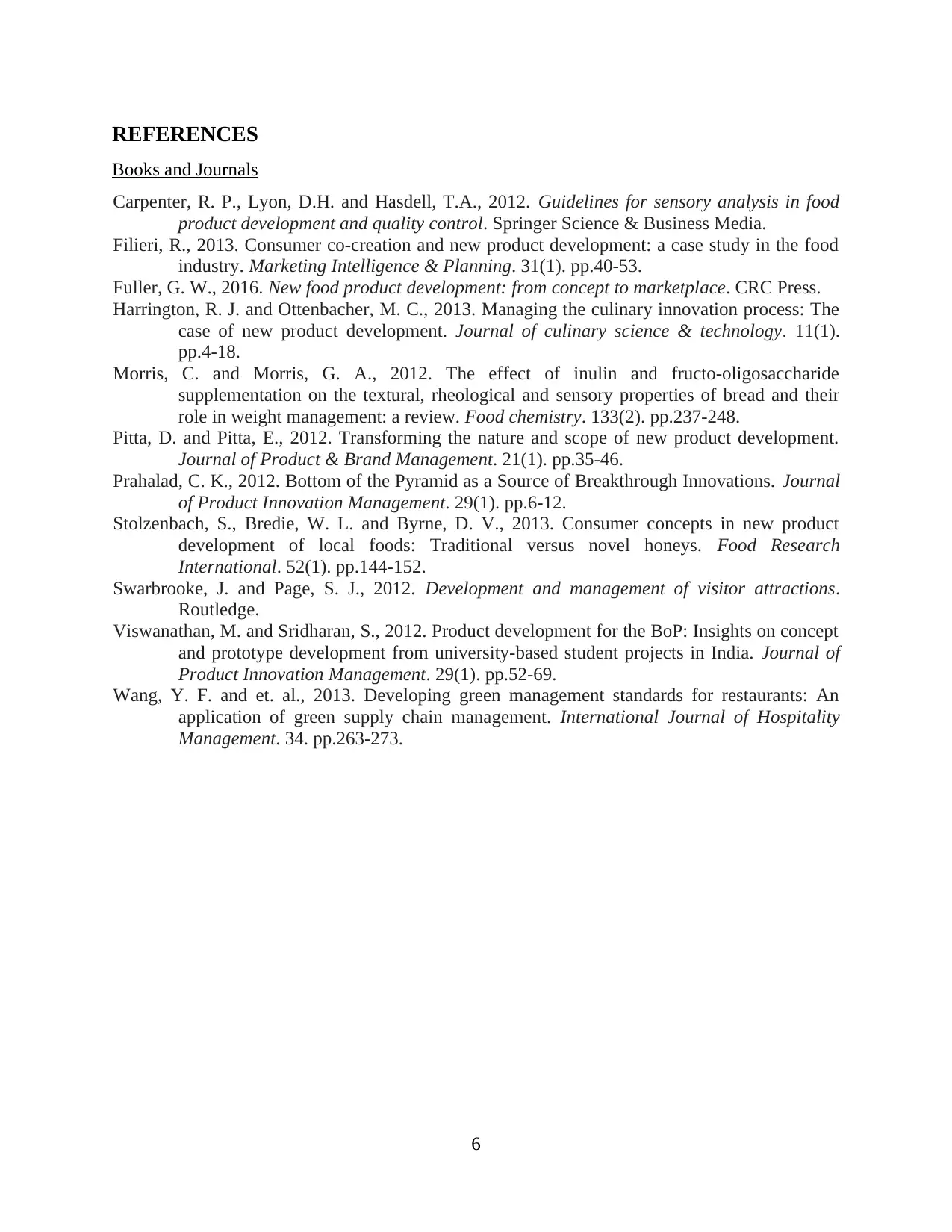
REFERENCES
Books and Journals
Carpenter, R. P., Lyon, D.H. and Hasdell, T.A., 2012. Guidelines for sensory analysis in food
product development and quality control. Springer Science & Business Media.
Filieri, R., 2013. Consumer co-creation and new product development: a case study in the food
industry. Marketing Intelligence & Planning. 31(1). pp.40-53.
Fuller, G. W., 2016. New food product development: from concept to marketplace. CRC Press.
Harrington, R. J. and Ottenbacher, M. C., 2013. Managing the culinary innovation process: The
case of new product development. Journal of culinary science & technology. 11(1).
pp.4-18.
Morris, C. and Morris, G. A., 2012. The effect of inulin and fructo-oligosaccharide
supplementation on the textural, rheological and sensory properties of bread and their
role in weight management: a review. Food chemistry. 133(2). pp.237-248.
Pitta, D. and Pitta, E., 2012. Transforming the nature and scope of new product development.
Journal of Product & Brand Management. 21(1). pp.35-46.
Prahalad, C. K., 2012. Bottom of the Pyramid as a Source of Breakthrough Innovations. Journal
of Product Innovation Management. 29(1). pp.6-12.
Stolzenbach, S., Bredie, W. L. and Byrne, D. V., 2013. Consumer concepts in new product
development of local foods: Traditional versus novel honeys. Food Research
International. 52(1). pp.144-152.
Swarbrooke, J. and Page, S. J., 2012. Development and management of visitor attractions.
Routledge.
Viswanathan, M. and Sridharan, S., 2012. Product development for the BoP: Insights on concept
and prototype development from university‐based student projects in India. Journal of
Product Innovation Management. 29(1). pp.52-69.
Wang, Y. F. and et. al., 2013. Developing green management standards for restaurants: An
application of green supply chain management. International Journal of Hospitality
Management. 34. pp.263-273.
6
Books and Journals
Carpenter, R. P., Lyon, D.H. and Hasdell, T.A., 2012. Guidelines for sensory analysis in food
product development and quality control. Springer Science & Business Media.
Filieri, R., 2013. Consumer co-creation and new product development: a case study in the food
industry. Marketing Intelligence & Planning. 31(1). pp.40-53.
Fuller, G. W., 2016. New food product development: from concept to marketplace. CRC Press.
Harrington, R. J. and Ottenbacher, M. C., 2013. Managing the culinary innovation process: The
case of new product development. Journal of culinary science & technology. 11(1).
pp.4-18.
Morris, C. and Morris, G. A., 2012. The effect of inulin and fructo-oligosaccharide
supplementation on the textural, rheological and sensory properties of bread and their
role in weight management: a review. Food chemistry. 133(2). pp.237-248.
Pitta, D. and Pitta, E., 2012. Transforming the nature and scope of new product development.
Journal of Product & Brand Management. 21(1). pp.35-46.
Prahalad, C. K., 2012. Bottom of the Pyramid as a Source of Breakthrough Innovations. Journal
of Product Innovation Management. 29(1). pp.6-12.
Stolzenbach, S., Bredie, W. L. and Byrne, D. V., 2013. Consumer concepts in new product
development of local foods: Traditional versus novel honeys. Food Research
International. 52(1). pp.144-152.
Swarbrooke, J. and Page, S. J., 2012. Development and management of visitor attractions.
Routledge.
Viswanathan, M. and Sridharan, S., 2012. Product development for the BoP: Insights on concept
and prototype development from university‐based student projects in India. Journal of
Product Innovation Management. 29(1). pp.52-69.
Wang, Y. F. and et. al., 2013. Developing green management standards for restaurants: An
application of green supply chain management. International Journal of Hospitality
Management. 34. pp.263-273.
6
1 out of 8
Related Documents
Your All-in-One AI-Powered Toolkit for Academic Success.
+13062052269
info@desklib.com
Available 24*7 on WhatsApp / Email
![[object Object]](/_next/static/media/star-bottom.7253800d.svg)
Unlock your academic potential
Copyright © 2020–2025 A2Z Services. All Rights Reserved. Developed and managed by ZUCOL.





